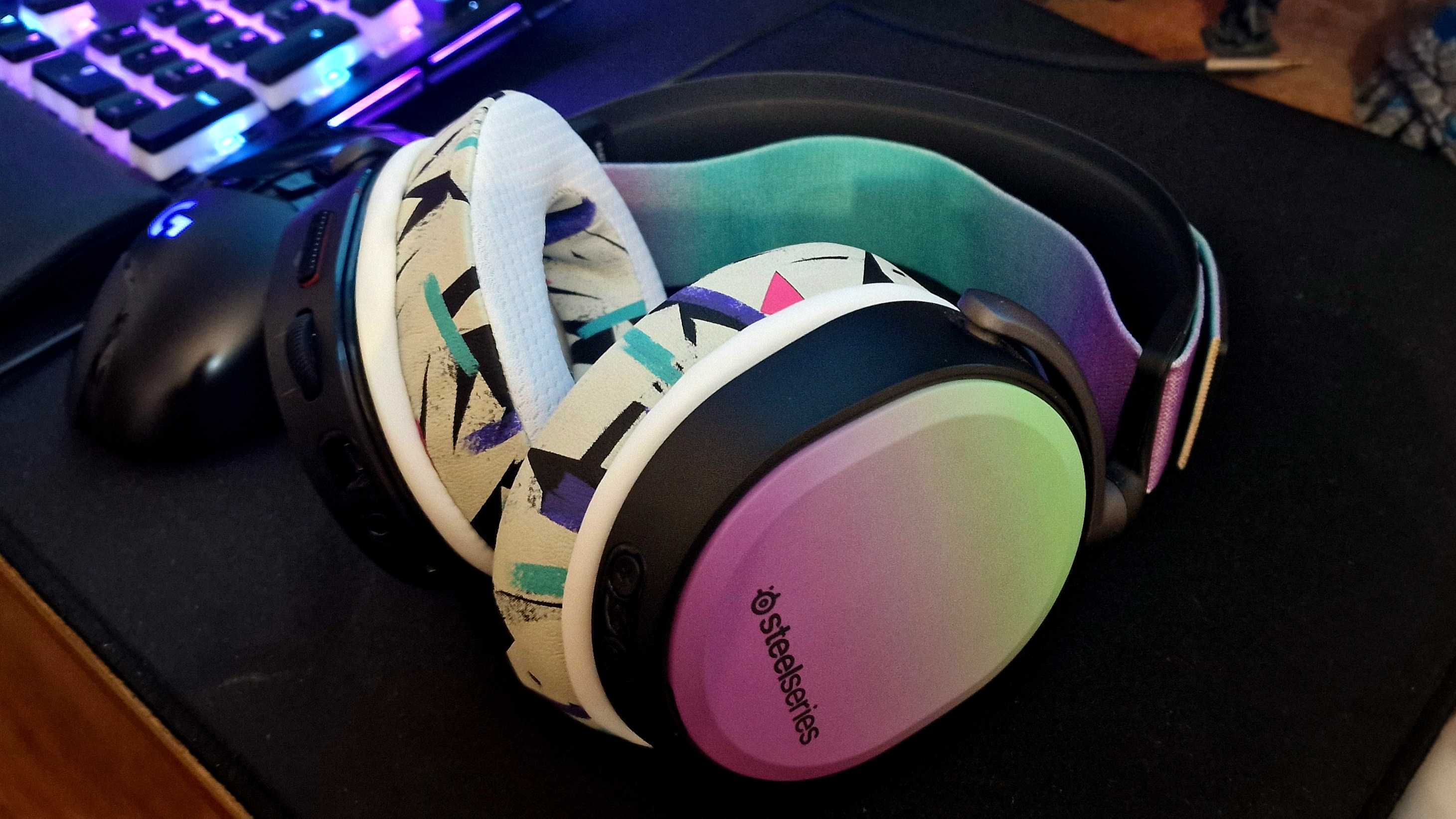Cooling gel ear pads are the cheap gaming headset upgrade I never knew I needed
Here's how a simple ear pad replacement made my gaming headphones infinitely better.

With the end of Summer in sight, we're fast approaching that time of year when the heat and humidity make even the best gaming headsets a sweaty, uncomfortable nightmare. After the warmth of the past few weeks, I was bored of ditching my SteelSeries Arctis Pro Wireless headset in favor of in-ear monitors so as not to boil my head. That's when a friend recommended I try upgrading my headset with cooling gel ear pads.
I was skeptical at first, thinking: "Surely it can't make that much of a difference?" But I've never been so happy to be wrong in my life. Here's how one quick tweak helped me game for at least twice as long without suffering from the heat.
After publishing a friend asked whether the pads would cause discomfort for gamers wearing glasses. I wear glasses when my eyes get strained, and with my Arctis Pro Wireless, it was no issue whatsoever—they were comfy and seamless. However, I recommend checking the dimensions of your headset and the replacement pads to see if they'll fit your headset comfortably.
So yes, cooling gel earpads really do make a difference to gaming. I wouldn't be writing this article if they didn't. No, seriously, I begged the Editors to let me write about this. I can't understate the difference it made to me having a comfier headset that kept my head cool, rather than the usual sticky, cheap junk we usually have to suffer under.
With my old ear pads, I'd get too warm and uncomfortable after an hour or two of gaming, and change over to my trusty Shure in-ear monitors. After switching out to cooling gel pads, the difference is like night and day or moist and dry.
Like many, I've been spending (maybe too much of) my time playing Baldur's Gate 3, and this Sunday I managed six hours straight before putting them down—and that was only because I had to make food, otherwise I would've kept on going.
That's more than double the time I would normally be able to stand gaming with my headset, and that was without putting the pads in the fridge for additional cooling. Because yeah, that's a thing you can do with them.

How do cooling gel ear pads work?
Most ear pads are cheaply made with a sponge ring wrapped in thin, perishable polyurethane (PU). Over time they start to degrade, sweat gets trapped in the sponge and they begin to irritate your skin.
Keep up to date with the most important stories and the best deals, as picked by the PC Gamer team.
With cooling ear pads, you get a layer of gel between a memory foam core and a breathable outer layer (sometimes fabric, sometimes perforated PU). This prevents your head from overheating and allows moisture to escape and evaporate.
The end result: you can game in comfort for much longer, and you can use them to cool down in the warm weather, too!
❄️ I'm thinking of buying a second pair, so I can stick one in the fridge and switch them out in-between rounds of Siege.
With higher-quality pads, you'll get multiple layers of gel and foam wrapped in a mix of PU and breathable fabric for better comfort and cooling. Some premium brands will also offer wider and thicker pads for better cushioning and noise cancellation, so be sure to check the size of your replacement and see how it'll fit.
I've had my own pads for a few weeks now, and they're just as effective, comfy, and pristine as when I bought them. That's not too bad, considering I use them every day—sneaking them into my work calls and busting them out for the Discord server when the squad's booted.
How do I replace my gaming headset ear pads?
This will depend entirely on the headset you own. For me and my Arctis Pro, it was just a case of pulling off the old pads, placing my thumb inside the new one, and running it along the overhang to secure it in place on the Arctis' frame.
Don't be afraid to use a little coercion to get them into position, but if you find yourself trying to force the fit, it's worth taking a step back and double-checking you're not about to break something.
It only took me two minutes to switch my ear pads out, and some pads are even easier to replace. For example, the Audeze Maxwell ear pads clip on and off with a simple twist.
If in doubt, check the website for your chosen pads. Most reputable brands will have videos on how to replace the pads on your specific headset.
What pads should I use?
There are plenty of cooling gel ear pads on Amazon, but a few brands stand out above the rest:
One problem you'll run into early on is that most of the replacement pads are black. That's not necessarily a bad thing, but if you want to add a bit of flair to your headset, and make it more unique while upping the cooling factor, it's slim pickings.
What I use: Wicked Cushions FreeZe ear pads
Lots of designs to choose from, and available for most headsets. WC uses a dual-layer cooling gel structure, with thicker, firmer memory foam, and wider pads for a premium fit and feel.
The internal stitching is reinforced with glue, and the materials are designed to prevent flaking and degradation. WC is so confident in the build quality, there's even a one-year refund or replacement policy—no questions asked.
What headsets will they fit?
You'll find pads available for most headsets, and Brainwavz even does universal replacements if you can't find a dedicated pair. Personally, I find Wicked Cushions offers the best quality and variety, and I've listed all of the models available at the time of writing below:
- Astro Gaming: A40 TR and A50 Gen 4.
- Audeze: Maxwell and Penrose.
- Audio Technica: ATH m50x, m50xbt, m50xbt2, m50, m40x, and m40.
- Beats by Dre: Studio 2, Studio 3, B0500, B0501, Solo 2, and Solo 3.
- Beyerdynamic: DT770, 770 PRO, 880, 880 PRO, 990, 990 PRO, TYGR 300R, MMX300, and 1770 PRO.
- Bose: 700, QuietComfort (2, AE2, 15, 25, 35, 35II, and 45), OE2 and OE2i.
- Corsair: Virtuoso, HS80, HS60, and Void.
- HyperX: Cloud (1, 2, and 3), Core, Flight, Flight S, Alpha, and Alpha S.
- Logitech: G PRO X.
- Razer Blackshark: V2 and V2 Pro (doesn't fit the 2023 model).
- Sennheiser: EPOS H6 PRO, GSP 500, GSP 550, GSP 600, GSP670, PC38X, PC37X, HD 559, HD 595, HD 598, and HD 599.
- Skullcandy: Crusher (Wireless, ANC, Evo, and 360), Hesh (1, 2, 3, Evo, and ANC), and Venue.
- Sony: WH1000XM3, WH1000XM4, WH1000XM5, MDR 7506, PS5 Pulse 3D, InZone H9 and H7.
- SteelSeries Arctis: 1, 1 Wireless, 3, 5, 7, 7+, 7P, 7P+, 7X, 7X+, 9, 9X, Pro, Pro Wireless, Prime, and Nova (1, 1X, 1P, 3, 7,7P, Pro Wired, and Pro Wireless).
- Turtle Beach: Stealth 300, 420X, 450, 600 (Gen 1 and 2), 700 Gen 1, Tango, Recon 50P, 50X, 70, 150, 200 Spark, and X12.

Andreas is the Editor-in-Chief of Tech Software at Future, spending most of his time writing about cybersecurity content. In his spare time he's an avid gamer and a lover of all things PC Gaming and D&D. He's previously written for StartMenu and PCGamesN, and published research on Dark Souls.


